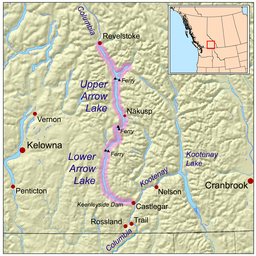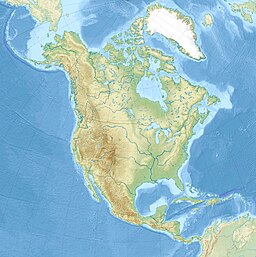| Arrow Lakes | |
|---|---|
 Upper Arrow Lake, south of Nakusp | |
 Map highlighting the Arrow Lakes | |
| Coordinates | 50°00′00″N 118°00′00″W / 50.00000°N 118.00000°W |
The Arrow Lakes in British Columbia, Canada, divided into Upper Arrow Lake and Lower Arrow Lake, are widenings of the Columbia River. The lakes are situated between the Selkirk Mountains to the east and the Monashee Mountains to the west. Beachland is fairly rare and is interspersed with rocky headlands and steep cliffs. Mountain sides are heavily forested, and rise sharply to elevations around 2,600 metres (8,500 ft).

Originally two lakes 23 kilometres (14 mi) apart, the Arrow Lakes became one 230-kilometre-long (140 mi) lake due to the reservoir created by the 1960s construction of the Keenleyside Dam; at low water the two lakes remain distinct, connected by a fast-moving section known as the Narrows.[1][2] Damming the Lower Arrow Lake resulted in water rising 12 metres (39 ft) above natural levels. As a result of higher water, the valley lost two-thirds of its arable land. Approximately two thousand people were relocated.[3] The lake stretches from just north of Castlegar in the south to Revelstoke in the north. Another hydroelectric development Whatshan Dam, diverted Whatshan Lake from the Whatshan River directly into the Arrow Lakes, just north of the Needles-Fauquier Ferry.
The Arrow Lakes are part of the traditional territory claims of the Sinixt, Okanagan[4] and Ktunaxa peoples, though at the time of contact and during colonization only Sinixt lived along its shores.

- ^ "BC Geographical Names". apps.gov.bc.ca.
- ^ "Recreation Areas – Arrow Lakes Reservoir". BC Hydro. Archived from the original on 26 June 2008. Retrieved 13 July 2008.
- ^ "Archived copy" (PDF). Archived from the original (PDF) on 26 March 2012. Retrieved 8 July 2011.
{{cite web}}: CS1 maint: archived copy as title (link) - ^ "Syilx Okanagan Nation – Okanagan Nation Alliance".


